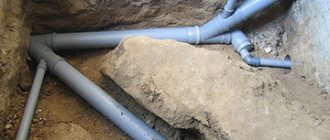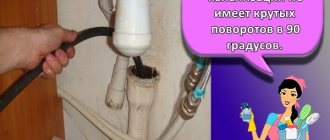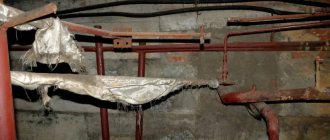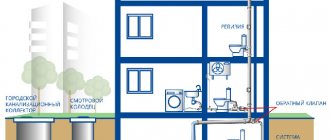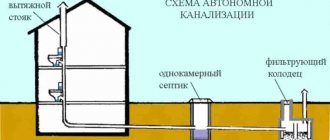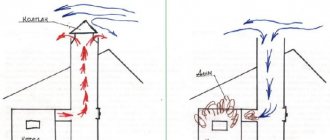Most owners of private houses are faced with an unpleasant odor in their rooms. You will need to know why the sewer smells and how to properly fix the problem with your own hands. There are many options for how to get rid of unpleasant odors in a private home.
ATTENTION! A unique, highly effective product has been developed for cleaning sewer pipes, eliminating any blockages. The product is a concentrated mixture of enzymes that easily break down and process fat accumulations and any deposits of organic origin. One package of Saniclean will last you a whole year! Read more"
Causes
Unpleasant sewer odor can occur due to many problems. It is recommended to carefully inspect the entire system to understand the reason. It is possible that such an examination will not bring positive results.
The following are the causes of unpleasant odor:
- There is no special fan ventilation, which is necessary for purging the sewerage. It may be incorrectly installed or broken. You will need to contact specialists who deal with this.
- Mistakes that craftsmen made when installing sewer systems. They may have miscalculated the height difference between the plumbing and the septic tank. This can result in a strong sewer smell in your home. In such a situation, it will be necessary to rebuild and re-equip communications.
- Cracks and various damage to elements of the sewerage system. This is dangerous because liquid may leak or drip from the pipes. The equipment will need to be repaired for the smell to go away.
- The water seal has dried out. If a drain is connected to the sink or bathtub and has not been used for a long time, then this problem may appear. You just need to turn on the water and the smell will go away on its own.
- There was a difference in atmospheric pressure. An unpleasant odor may appear due to the fact that the sewer system is not designed correctly or is broken.
- Blockages. The most common cause of drain odors is clogged pipes.
You will need to eliminate the cause of the smell in the sewer. There may be several of them, so it’s best to call a professional or try to remove the stench with your own hands. It is best to carefully look at all outlets, sinks and toilets. If the cause of the unpleasant odor has been found, it must be eliminated.
Methods for improving the smell in an apartment
You have fixed all the problems with the pipeline, increased the ventilation of the premises, but the heavy, musty smell is still noticeable. At the last stage of the struggle, add products that have a pronounced pleasant aroma. Aromatherapy will help improve the atmosphere of the apartment, fill it with comfortable tranquility, or, conversely, add vigor and a feeling of celebration.
Store flavors
On the shelves of retail chains you can find many products for aromatizing the air in the apartment. These can be sprays, diffusers (transparent bottles with aromatic liquid and bamboo sticks inserted into it), scented candles, aroma lamps with essential oils, automatic sprayers. Their purpose is to make the indoor air pleasant to our sense of smell. All of them mask bad sewer fumes, but do not affect the source of their occurrence. Neutralizers and absorbers of unpleasant odors stand separately. They are small devices filled with some kind of absorbent component. Air enters the neutralizer through numerous holes, where it is cleaned of harmful impurities.
Strong-smelling products at hand
Folk remedies will help make your home atmosphere more comfortable. Rooms with high humidity can be refreshed by placing small containers filled with coarse sea salt mixed with a few drops of any essential oil. Salt will remove excess moisture, and essential oil will fill the room with a light aroma. Coffee beans, citrus peels, and dry herbs have a rich aroma. They are poured into bowls or packaged in sachets made from natural fabrics.
Placed in different parts of the home, such environmentally friendly fragrances will give the apartment a subtle, subtle smell.
Cleaning
Thorough cleaning and regular ventilation of the premises will help improve the air in your home. Modern cleaning products successfully remove any dirt from plumbing fixtures. Apply the cleaning gel to the earthenware surface of the toilet bowl - it will instantly dissolve the limescale deposits. Antibacterial components of detergents suppress the proliferation of microorganisms and prevent the appearance of unpleasant stench from the bathroom. Don’t forget about preventing blockages: cover the drain holes of the kitchen sink or shower stall with special meshes - this will protect the siphons from small debris. At the first signs of blockages, try to clean the siphons with any preparation that dissolves organic matter. They are produced in the form of a solution, thick gel, and dry granules. Otherwise, the unpleasant smell of sewage will fill the house.
Get rid of excess dampness: after washing, leave the washing machine door ajar, do not dry laundry in the apartment, and equip the bathroom with additional ventilation. If you have pets, keep the litter box clean. Change the filler more often, disinfect the tray and the floor around it. Special aerosols will help neutralize the smell of urine.
The article has been verified by the editors
Odor danger
Sewer smell is dangerous to human health. Few people know about this, since many people think that the stench is simply unpleasant. Gas fills the cavity of the pipes and enters the house through a siphon. The smell can cause severe harm to a person if it penetrates into an apartment in large quantities.
Drain stench can be dangerous due to the following components:
- Methane. It does not lead to serious poisoning as it causes a chronic condition. If you constantly inhale it, you will experience headaches and arrhythmia. The main danger of methane is that it can ignite or explode.
- Carbon dioxide. It is much heavier than air, so it enters the apartment in small quantities. Carbon dioxide is harmful to animals and humans. When people sleep, it enters the lungs, causing severe fatigue and weakness.
- Hydrogen sulfide. It is very toxic and affects the human central nervous system. The component reduces sensitivity to odor. After a while, a person stops feeling the smell in the air.
- Hydrogen. It is not dangerous in itself. It is best that there is no sewer smell in the apartment.
It is recommended to get rid of the problem immediately to avoid serious health problems. An unpleasant odor begins to accumulate in the apartment, and the components begin to destroy the human nervous system.
Causes of unpleasant smell from sewerage
The sewer system of any home is designed to remove various sewage: human waste products, dirty water after washing, washing dishes, and wet cleaning. The remains of spoiled food are sometimes flushed down the toilet.
The process of waste decomposition occurs with the help of putrefactive bacteria, and a significant amount of hydrogen sulfide is released. This foul-smelling gas comes from sewer pipes.
You should not put off eliminating this problem for too long - upholstered furniture, carpets, curtains or other home textiles quickly absorb all kinds of odors, accumulate them, and then it is difficult to get rid of the barely noticeable but persistent stench. Hydrogen sulfide, methane, and mold released into the air can cause allergic reactions in households, attacks of bronchial asthma, and, in high concentrations, poisoning.
To effectively eliminate a specific smell from the sewer system in an apartment, you need to find its source. The main causes of stench:
- clogged pipes and siphons;
- lack of a water seal;
- ventilation system problems;
- presence of hidden leaks;
- improper installation of plumbing structures.
Finding installation errors
In order to eliminate malfunctions that occurred during installation, you will need to understand how the sewer system works.
The toilet should be connected to the riser lower than all other fixtures in the bathroom. The outlet should have a diameter of 10 centimeters. The dimensions of other connections are at least 7 cm. If everything is installed correctly, there will be no blockages.
If there is little water flow in the bathroom, the sink is clogged, or there is an unpleasant smell in the kitchen that cannot be removed with a freshener, you need to act immediately. With the help of Saniclean you can easily cope with the situation without a plumber... Read more»
Improper installation of communications
If residents who have moved into a new house feel a not-so-pleasant “aroma” in the rooms, perhaps the builders or DIYers made mistakes when installing the sewer system.
Due to violations associated with the laying of pipes - especially non-compliance with the angle of inclination, which is prescribed in the standards, wastewater in the pipes can stagnate, causing a specific odor.
When laying a sewer system, it is important to comply with engineering requirements: all work must be carried out in strict accordance with current regulations
A radical way to get rid of the stench will be a complete replacement of communications with the installation of a new system in strict accordance with technical specifications.
In some cases (when using metal-plastic pipes), the situation can be saved by adjusting tightened pipe connections, replacing gaskets, and installing specially selected sealing collars.
In order to prevent clogging, it is periodically necessary to flush the sewer system, the rules for which will be introduced in our article.
How to get rid of blockages
If the sewer is clogged, a stench will appear in a private home. When debris accumulates in the siphon, it is dismantled and cleaned. If the pipes are clogged, then mechanical methods and chemicals must be used. You can try to remove the blockage with a plunger, which will help push out all the dirt. The steel cable will be able to break small pieces of debris into pieces so that they can then be easily washed away.
If you choose chemicals, you should look at the material of the pipes. It is recommended to clean cast iron with various gels. These products contain acids and alkalis. The packaging will tell you how to use the chemicals correctly so as not to harm the pipes.
The sink is clogged
First let's run the water in the sink. If the water stagnates or leaves slowly, then a blockage has formed in the siphon, or in the socket, which is located between the washbasin and the siphon.
The blockage in the siphon is removed by disassembling the device and cleaning it with detergents. Next, you need to install the siphon in place and check the operation.
If the cause is not eliminated, then you need to use a special cable to clean the pipe.
Before using the cable, the sink is pumped using a plunger, which removes the plug and temporarily restores the flow of liquid. The plunger method is not radical.
Removing clogs in the sink.
If there is water in the sink, then you need to clean the siphon in the usual way. If the washbasin and sink are filled at the same time, it means that the blockage lies in the drain pipe common to these plumbing fixtures. A cable is used for cleaning.
Removing blockages in the bathroom.
The bathtub is prone to clogging with hair and animal hair that wrap around the drain grate.
You can remove the plug using a wire hook, after first removing the grille. Next, clean the pipe using a cable.
How to clear clogs in the toilet.
A clogged toilet in a private home is considered a serious problem.
And the siphon in the toilet passes the liquid into the riser, which has a larger cross-section than the drain pipe. As a rule, a clog in the toilet is caused by a rag. The drainage from the riser goes back into the toilet, and with it the odors.
To remove such a plug, it is better to call specialists.
Problems with the water seal
In order to create a water seal, you need to take a curved pipe so that its elbow is below the drain level. A barrier with tap water is installed in it, which will not allow the stench to pass through. When liquid flows through the pipes, it will be replaced by water.
Problems in the system can happen due to:
- Cracks in the siphon.
- A water plug that is drawn into the sewer.
- Rare use of the system.
If the fluid in the knee dries out, it is recommended to open the tap to restore the fluid level. When damage appears in the channels or siphon, it is necessary to lubricate it with sealant.
How to eliminate sewer smell in the bathroom, kitchen, toilet
We have looked at the main reasons why there is a sewer smell in the bathroom and other rooms. Almost all of them can be eliminated on your own. Let's talk about how to do this correctly.
Elimination of design and installation errors
If the stench appears after a major renovation or installation of new communications, it is worth assuming that the problem is due to poor design. Unfortunately, correcting errors in this case is very labor-intensive and expensive. It is necessary to dismantle the communications and reinstall them, but without any defects. Sometimes partial dismantling and alteration of individual components is “shown.”
So, for example, in the absence of inspection hatches through which inspection and repair of communications are carried out, they are installed in the process of partial dismantling. In more serious cases, it is necessary to redesign the system. If you have no experience in carrying out such work, it is better to entrust it to specialists.
Problem in the ventilation system
If there is a sewer smell because the ventilation system is faulty, there is a simple action you need to take. You will need to attach a piece of paper to the hole. If it falls, the ventilation has stopped working. In such a situation, all pipes will need to be thoroughly cleaned. If ventilation is very poor, then experts advise installing a forced-air system to purify the air. To do this, a special fan is installed in the hole. It works well to clear the air of sewer stench.
Preventive measures
Typically, residents of private houses connect sewer structures directly to cesspools. There are three types:
- without bottom;
- sealed;
- septic tank
Not a single pit from the above is immune from silting up and serving as a source of stench. You can clean the structure by various means: with a bucket on a long rope, using a drainage pump, a suction pump equipped with special machines, as well as using sanitary bio-cleaning and chemicals for home cesspools.
Of course, it is safer and more beneficial to use biological products. These can be special powders, tablets or liquid products, but they have a small disadvantage. The composition of bioactivators includes microorganisms that multiply well during the warm period; in winter, the microbes do not work at full strength and do not remove the smell.
Among chemical agents, the best option is all nitrate oxidizers. Ammonium salts and formaldehyde are highly toxic to humans and animals, so it is best not to use them in this situation.
If, after pumping out sewage from the pit and cleaning it, it still stinks, then look for the problem elsewhere. Let us remind you that an obsessive stench can be provoked, for example:
- a drain pipe that was installed in violation of the standards;
- clogged ventilation duct or improperly equipped ventilation system, lack of an exhaust fan;
- clogged sink hole;
- poor cleaning of the siphon or drain.
Repairing small cracks
Pipes can leak at the joints. If the pipes have moved, they must be returned to their place. When rubber seals on plastic pipes break, they will need to be completely replaced with new ones.
In order to remove leaks in sewer channels, water is drained and dried. Next you will need to saw off a small piece of pipe of the same length and cut it lengthwise. Where a crack or tear has formed, it is necessary to anoint it with special glue. Next you should put the patch and press on it. If microcracks have formed in cast iron fixtures, then you will need to use cold welding.
Microcracks in the drain of the sewer system
Another possible cause of unpleasant odors is microcracks or diaper rash that form in inaccessible places. They become sources of sewer “odors” and are very difficult to find and eliminate. Way out of this situation:
- replacing a damaged pipe with a new, better one;
- treating all suspicious areas with a sealant.
Connecting plumbing to the sewer
In order to prevent leaks from occurring in the future, and therefore the appearance of foreign odors from drainpipes, it is necessary:
- install high-quality plumbing pipes, only from trusted manufacturers (although they are not very cheap);
- when laying drainpipes, it is recommended to make as few joints as possible; cracks most often occur in these places;
- perform high-quality waterproofing of the floor and walls in the bathroom or toilet;
- place joints only in easily accessible places, although this is not always possible.
Pipes are frozen
A sewer smell may appear due to severe frosts outside. You will need to check for ice blockages. It happens that ice appears inside, so the opening narrows and the water drains much more slowly. It begins to stagnate there and eventually stinks throughout the entire apartment.
First of all, you need to find the area where the pipe is frozen. You can add hot water along with salt. To prevent the plug from appearing again, you will need to check whether the toilet tank or faucet is leaking. It is best to insulate the pipeline so that such unpleasant situations do not occur.
Sealing cracks in sewer pipes
It is clear that a leaky pipe or other element needs to be replaced, but the following can be done as temporary measures:
If the breakdown has a round shape
You can offer several “amateur” options:
- Hammer a short, conical-shaped wooden plug into the hole (the long one will collect dirt).
- Wrap the damaged area with gauze or a bandage and then impregnate them with epoxy resin.
- Wrap the area with the fistula with a wide rubber band (with tension), and then pull it tightly with several turns of wire.
“Proper” repair involves installing a clamp with a rubber gasket or a repair coupling.
If the hole looks like a crack
Icing, which was described above, leads to the appearance of such defects. They can also be caused by pipe defects.
If the crack is not through, it must be carefully widened, cleaned, treated with a degreaser and, after drying, filled with sewer pipe sealant.
Through cracks are reliably sealed by “cold welding”, also applied to a degreased surface.
Correct installation - working on mistakes
To identify installation errors that lead to blockages and the smell of hydrogen sulfide, you should know the basic rules for sewerage installation:
- The toilet is connected to the riser at a separate entry point below all other devices. The remaining devices are connected higher; there can be several devices on one line, if bandwidth allows.
- The diameter of the outlet from the toilet is 100 mm, the riser should not be narrower. The diameter of the remaining connections is no less than the diameter of the outlet pipe from the plumbing fixture, and preferably 70 mm.
- The distance between the toilet and the riser is no more than 1 meter. Other devices can be installed at a distance of no more than 3 meters.
- If it is necessary to make a connection to the riser at a distance of more than 3 meters, it is made from a pipe of 70 mm or more. The thickness of a 5-meter line is at least 100 mm.
Optimal operation of the sewer system without blockages, with normal flow and absence of odors will be ensured by compliance with the slope and height difference. The horizontal slope of the sewer pipe depends on the diameter: for 50 mm - 3 cm per linear meter, for 100 mm - 2 cm. The maximum height differences should be 1 m for the toilet, 3 m for other devices.
A common mistake is to use 90° shaped corners to design turns, in which water bounces off, which contributes to the rapid formation of blockages. To create a smooth flow, 135° turns are used.
A careful inspection of the internal installation will reveal any malfunctions, if any. Eliminating many will require a small investment of money and time. If the smell appears almost immediately after installing the system, the cause is improper installation.
Removing odor from hands and preventive measures
After working with sewer pipes and clogs, an unpleasant odor remains on your hands for a long time. Sometimes neither rubber gloves nor soap can save you. Try cleaning your hands with rubbing alcohol. It will eliminate the “heavy spirit” and disinfect the skin. You can use eau de toilette or liquid deodorant.
Fresh parsley contains essential oil with a tart and pleasant aroma. For the effect, you need to grind two or three branches of this herb in your palm. If you don’t have parsley on hand, there is always a piece of lemon in the refrigerator. As a last resort, using regular food vinegar will help. After using any product, wash your hands with warm water and lubricate with cream.
On a note! Use a cream with a citrus scent: it will help completely deal with any unpleasant odor.
Any siphon or pipe can become clogged - even when used correctly. For prevention, all drains in the house should be washed with boiling water every 14 days. You can add any product with a pleasant smell to the water. Since all new siphons are dismountable, they should be disassembled and cleaned every 30 days. Once every six months, it wouldn’t hurt to clean all the pipes with caustic soda or another chemical, but this should not be abused so as not to cause harm to the sewer system.
The best way to prevent blockages in pipes is to prevent them. Do not pour large food waste down the sink or sink, even if it is soft and passes through the drain. All plates and cups should be thoroughly cleaned and checked before placing them in the sink or dishwasher. Timely cleaning of plumbing fixtures with household chemicals will also help eliminate any unpleasant odor: chemicals effectively dissolve residual fat and mineral deposits contained in water.
Proper installation of the sewer system and timely replacement of old communications will also help avoid blockages and unpleasant odors. If the sewer spirit persists in the apartment through no fault of the owner, you need to seek its elimination by contacting the local housing office.
Restoring ventilation
If the apartment smells like sewage, and the sources of the problem have not been identified, it is quite possible that the reason for this lies in a malfunction of the ventilation system. Homes usually have a natural draft of ventilation.
To check the operation of the ventilation structure, a simple test is carried out - a sheet of paper is applied to the grille.
With normal draft, it will be held by the air flow, in other words, it will simply “stick” to the grille. In the absence of ventilation, mold and mildew form on the walls, resulting in a slight but rather unpleasant odor.
The problem of poor ventilation can be solved in the following ways:
- Clean clogged channels. This work must be performed by specialists. It will not be possible to cope with this task on your own, since poor ventilation is most likely associated not only with blockage near its entrance to the apartment, but throughout the house.
- Create forced ventilation by installing a fan in the existing duct. You can handle this work yourself.
There are many reasons why there is an unpleasant sewer smell in the house. In order to eliminate this problem, you must first determine its source. The appearance of an odor may be due to clogged drains, problems with siphons and “water locks,” as well as problems with leaking pipes in the basement. It is possible to cope with the appearance of an unpleasant stench only if the cause of the problem is discovered, and it can also lie in the apartment plumbing - clogged pipes in the bathtub, sink, shower stall. Some problems, such as cleaning pipes, can be dealt with on your own, but in other situations it is better to turn to plumbers if you do not have the necessary knowledge to replace pipes, fix leaks and solve other similar problems.
The appearance of leaks
If drains begin to leak at the junction of elements, the fastest way to correct the situation is with the help of a special sealing tape. It appeared relatively recently, consists mostly of polyethylene and is intended to solve precisely this kind of problem. Sealing tape is used as follows:
- Dust and dirt are washed off from the surface of the pipes at the junction, and then dried.
- Trying to pull it tighter, the tape is wound around the joint and adjacent sections of pipes. It should lie without wrinkles or folds. Each turn overlaps the previous one by half the width.
- Having passed the joint in one direction, they begin to move in the opposite direction, so that the tape is ultimately laid in two layers.
- If the joint to be sealed is located outdoors, the tape must be protected from UV radiation with an additional coating or casing.
One of the reasons for leaks, as already mentioned, is the loss of elasticity of the sealing rubber due to natural aging. In this case, it is recommended to additionally coat the joints with silicone sealant for sewer pipes. This is especially true for pipelines laid in a hidden way, for example, from a drain built into the floor.
It is better to use a neutral sealant, since an acidic one (it is cheaper) can have a negative effect on some materials.
Another common cause of leaks is stagnation of water in the pipe due to a blockage.
Clogged sewer - ways to get rid of it
Putrid smells often come from clogged siphons, but under certain conditions they can also come from other areas. If a slowdown in drainage is noticed, accompanied by a putrid spirit from the sink, a plug of dirt and grease has formed in the siphon, preventing the water from draining normally. The liquid stagnates, putrefactive bacteria quickly multiply in it, the waste products of which are gases that poison the air. There are several ways to get rid of a grease and dirt plug, depending on the degree of access to it.
If the siphon is accessible and made of plastic, the easiest way is to unscrew it, wash it with warm water and soap and put it back together. Cleaning will be 100%.
A less labor-intensive method is chemical: you can use industrial or home remedies. The method of using ready-made products is explained in the instructions for use. Please pay attention to the purposes for which the product is intended:
- preventive – for periodic use to prevent blockages;
- active – if it is noticed that the water has begun to drain more slowly;
- emergency – serious gaps are eliminated.
Please pay attention to the characteristics of the products: universal – for all occasions, fat-breaking – for the kitchen, hair-breaking – for the bath.
For home remedies, we use baking soda, citric acid, and vinegar. To prepare a working solution, take half a glass of soda or 2 packets of citric acid, dilute it with hot water, about 3 liters. Pour the liquid into the drain. You can use baking soda and vinegar. First, pour a glass of soda into the drain, and pour a glass of vinegar there. A violent reaction begins, corroding the fat. After use, rinse the system with water. Home remedies are suitable for the kitchen as preventive measures; they will not remove severe blockages.
Among the mechanical means we use a plunger and a plumbing cable. Cleaning with a plunger is very simple: place the plunger on the drain hole of the sink with water, press firmly several times and remove with a jerk. If the water drains quickly, the blockage has been removed. If not, we repeat the procedure.
If the plug has formed at a distance from the appliances, use a plumbing cable. We do the work together. First, we open access to the place of blockage, for example, remove the siphon or covers on the riser. We insert the cable into the pipe and begin to move deeper. Another person rotates the handle of the cable, winding various debris around the cable. If the end of the cable rests, we still move forward, destroying the blockage. After removing it, we flush the system.
